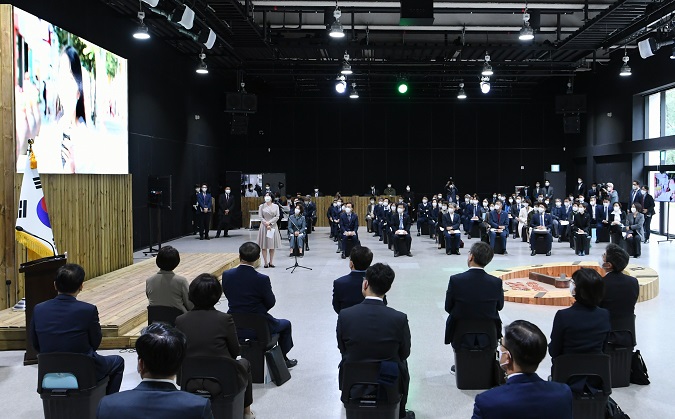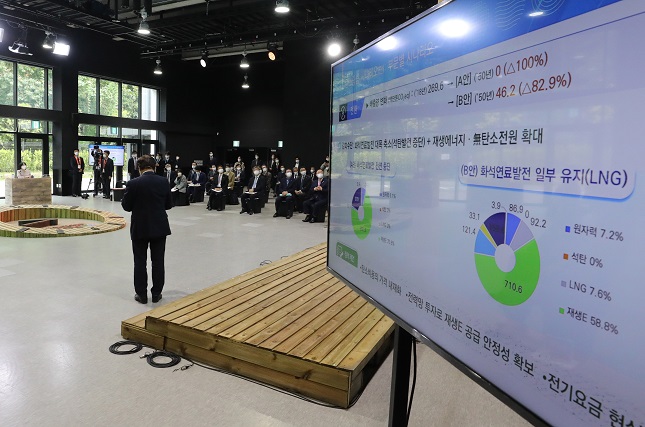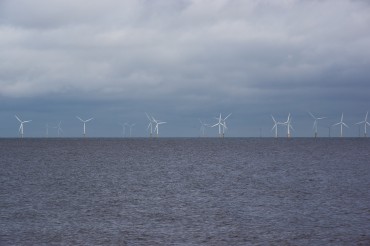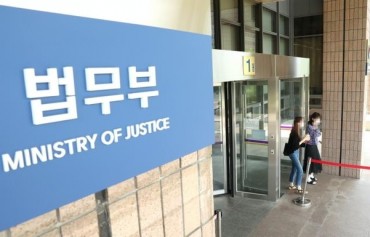
Government officials attend a carbon neutrality committee meeting in Seoul on Oct. 18, 2021. (Yonhap)
SEOUL, Oct. 18 (Korea Bizwire) — The presidential committee on carbon neutrality on Monday unveiled two upgraded policy road maps, including scrapping coal-fired power generation, to achieve South Korea’s net-zero emissions goal by 2050.
Presided over by President Moon Jae-in, the committee held its second general meeting in Seoul to review and approve agendas for the country’s carbon neutrality and green house gas (GHG) reduction plans.
In August, the committee announced a draft for three scenarios for the country’s 2050 net-zero emissions goal. But two of the scenarios were criticized by environmental groups claiming they do not guarantee net-zero emissions by 2050.
After holding public hearings and collecting feedback from various communities in the past two months, the committee came up with revised road maps in two scenarios, both of them calling for the end of coal use in power generation.
“This is an opportunity of innovation in which we can upgrade our industry and energy structure to a low-carbon economic system,” said Prime Minister Kim Boo-kyum, who co-chairs the carbon neutrality committee.
“In a step toward carbon neutrality, we will be able to secure future growth engines and create new jobs.”
While two scenarios all target net-zero emissions by 2050, they have different proposals in sectors like power supply, transportation, hydrogen, and carbon capture, utilization and storage (CCUS).
The first scenario aims to eliminate all thermal power generation using fossil fuel and liquefied natural gas (LNG) to have zero emissions in the power supply sector.
The second road map also aims to abolish coal-fired power generation but will keep LNG as a flexible power source, which will generate some emissions.
However, the plan seeks to boost CCUS and direct air capture (DAC) capabilities to achieve net-zero emissions, according to the committee.
When it comes to the transportation sector, the first scenario targets to have 97 percent of vehicles to be electric vehicles (EV) or hydrogen-powered cars.
The second scenario aims to see 85 percent of cars on the road to be environment-friendly, and the remaining combustion-engine vehicles to use alternative fuels like e-fuel.
Both road maps also include proposals for expanding use of renewable energy sources and enhancing energy efficiency of buildings.

A government official explains the government’s net-zero emissions goal at a carbon neutrality committee meeting in Seoul on Oct. 18, 2021. (Yonhap)
The government earlier this month announced its ambitious goal of reducing greenhouse gas emissions, or nationally determined contribution (NDC), from 26.3 percent to 40 percent by 2030 compared with 2018 levels.
Such a goal was confirmed by Moon at Monday’s meeting.
At its latest meeting, the committee made slight changes on the portion of domestic and overseas GHG reduction targets.
Of the country’s 40 percent reduction goal, the domestic sector will represent 35.4 percent, up from 35.2 percent, while the overseas portion will go down from 4.8 percent to 4.6 percent.
By sector, the country seeks to cut GHG emissions in the power supply sector by 44.4 percent from 269.6 million tons in 2018 to 149.9 million tons in 2030.
In the industrial category, it aims to reduce GHG emissions from 260.5 million tons in 2018 to 222.6 million tons in 2030.
The government’s latest carbon vision, however, drew mixed responses from academia and the private sector questioning the feasibility of the goal.
They say that it does not reflect preparations required for related facility and technology developments under the scenarios and lacks accurate projections in costs.
Business lobbying groups expressed their regrets over the country’s carbon neutrality and GHG emissions goals, saying such targets could negatively influence a company’s expansion and investment plans.
Environmental groups criticized that the scenarios lack interim objectives and have uncertain measures.
Meanwhile, the committee said the agenda discussed at its meeting will get final confirmation at a Cabinet meeting on Oct. 27 and added that its upgraded 2030 GHG emissions goal will be announced globally next month at the 26th UN Climate Change Conference of the Parties in Glasgow, Britain.
(Yonhap)






